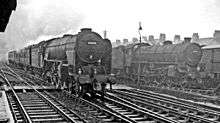LNER Thompson Class A2/3
- Disambiguation: LNER Thompson Class A2
|
No. 517 Ocean Swell in 1947 | |||||||||||||||||
| |||||||||||||||||
| |||||||||||||||||
| |||||||||||||||||
| |||||||||||||||||
The London and North Eastern Railway (LNER) Class A2/3 was a class of 4-6-2 steam locomotives. They were newly constructed locomotives, fulfilling the requirement identified by Edward Thompson for a standard express passenger locomotive of the 4-6-2 arrangement with 6 ft 2 in (1.880 m) driving wheels. Fifteen engines were constructed according to this original design, but following the retirement of Thompson as CME, the remaining fifteen locomotives that were planned were immediately redesigned and ultimately emerged as Peppercorn Class A2.
Background
When Edward Thompson was appointed Chief Mechanical Engineer of the London and North Eastern Railway in April 1941, he envisaged a new standardisation programme involving ten locomotive designs including two Pacific types.[1] These were an express passenger type (designated A1) with 6 ft 8 in (2.032 m) driving wheels and a ‘heavy passenger and freight’ type (designated A2) with 6 ft 2 in (1.880 m) driving wheels. He was not able to proceed with his plan due to the Second World War but did try out some of his ideas by rebuilding Nigel Gresley’s P2 class 2-8-2 as A2/2 pacifics and building the last four V2 class already on order as A2/1 pacifics. At last in April 1944 Thompson received authority to build thirty new locomotives of his A2 type during 1945, and a further thirteen during 1946.[2]
Design
The basic design of the locomotive was similar to the A2/2 rebuilds in terms of the frames, boiler and motion, but boiler pressure was increased to 250 psi (1.72 MPa) and the cylinder diameter was reduced to 19 in (483 mm).[2] The locomotives retained Thompson’s divided drive with the middle cylinder driving the first pair of driving wheels and the outside cylinders the middle pair. However, In order to have three connecting rods of the same length with three independent sets of Walschaerts valve gear, the outside cylinders were set back behind the bogie.
Building
The locomotives were due to be built at Doncaster works but were subject to various delays and so only the first, No. 500 appeared in traffic in May 1946, prior to Thompson’s retirement aged sixty-five, the following month. Fourteen further examples were then under construction and appeared under Thompson’s successor Arthur Peppercorn, between July 1946 and September 1947. After trials during the summer and autumn 1946 Peppercorn decided not to build the remaining locomotives authorised until he had made modifications to the design.[2] In fact O.S. Nock has suggested that the Doncaster staff had begun amending the design before Thompson’s retirement.[3] The class was then redesignated A2/3, and the Peppercorn design became the standard A2 class.
Performance
The class performed adequately but according to Nock, they suffered from ‘the long spacing between the bogie and the leading coupled wheels, resulting in undue flexing of the frames and constant troubles from the outside pipe connections to the valve chests.’ [3] However, in the opinion of Allen the A2/3 class were ‘the best 4-6-2s turned out during his [Thompson’s] superintendence,’.[4]
Stock list
| LNER No. |
BR No. | Name | Entered stock | Withdrawn |
|---|---|---|---|---|
| 500 | 60500 | Edward Thompson | May 1946 | June 1963 |
| 511 | 60511 | Airborne | July 1946 | November 1962 |
| 512 | 60512 | Steady Aim | August 1946 | June 1965 |
| 513 | 60513 | Dante | August 1946 | April 1963 |
| 514 | 60514 | Chamossaire | September 1946 | December 1962 |
| 515 | 60515 | Sun Stream | October 1946 | November 1962 |
| 516 | 60516 | Hycilla | November 1946 | November 1962 |
| 517 | 60517 | Ocean Swell | November 1946 | November 1962 |
| 518 | 60518 | Tehran | December 1946 | November 1962 |
| 519 | 60519 | Honeyway | February 1947 | December 1962 |
| 520 | 60520 | Owen Tudor | March 1947 | June 1963 |
| 521 | 60521 | Watling Street | May 1947 | November 1962 |
| 522 | 60522 | Straight Deal | June 1947 | June 1965 |
| 523 | 60523 | Sun Castle | August 1947 | June 1963 |
| 524 | 60524 | Herringbone | September 1947 | February 1965 |

- With the exception of 60500 all of the locomotives were named after the winners of major flat races in the immediate postwar period:
Accidents and incidents
On 7 January 1957, No. 60520 Owen Tudor was hauling an express passenger train which overran signals and crashed into the rear of a local train at Welwyn Garden City, Hertfordshire.[5]
Withdrawal
The A2/3s were withdrawn from stock between August 1962 and March 1965. None was preserved.
Models
Apple Green Engines produce a ready-to-run model of the A2/3 in 4 mm scale. PDK and DJH both sell 4 mm scale kits of the A2/3. Crownline have also produced a 4 mm scale kit, but this is no longer available.
DJH also sell a kit of the A2/3 for O gauge (7 mm scale).
References
- Allen, Cecil J. (1962). British Pacific Locomotives. London: Ian Allan.
- Nock, O.S. (1984). British Locomotives of the Twentieth Century Vol. 2 1930-1960. London: Book Club Associates.
- Boddy, M. G.; Neve, E.; Yeadon, W. B. (April 1973). Fry, E. V., ed. Locomotives of the L.N.E.R., Part 2A: Tender Engines—Classes A1 to A10. Kenilworth: RCTS. ISBN 0-901115-25-8.
- Yeadon, W. B. (1991). Yeadon's Register of LNER Locomotives, volume 3: Raven, Thompson & Peppercorn Pacifics. Irwell Press.
